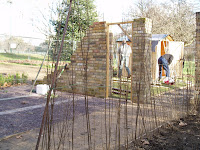Volunteers arrived yesterday to spend another day working on the garden. You would forgive the group for being less enthusiastic second time around but arriving in the rain and the wind they showed no signs of flaking or disengagement. Their keenness was inspiring and they portrayed
admirable enthusiasm as they knuckled down to get the jobs done. The main objective of the day was to add more plants in the raised beds, the plants were carried into the garden and their suitable spot on the raised bed was found, then the planting begun. Vast numbers of plants added meant that before our very eyes appeared a rippled green sea of
foliage with waves of purple, yellow and white. The progress was amazing and the whole team felt a huge sense of achievement as we left for lunch.
The trellis was still standing much to the relief of the volunteers who put it up! Time was spent planting Ivy next to the structure which looked really good. The plants are obviously small at the moment but with the support of the trellis and the care of the volunteers it wont be long until they act as a
shield for the front garden and a safe getaway for the resident birds.
Last job on the list was to empty the bog, the next volunteers day involves planting in the pond and wet area so the water needed to be drained before doing this. It was the

bog that needed emptying as it
inevitably had gotten really wet during the rainy weather. It was the job of two members of the Wild in the Parks trio; Martyn and Rachel to do, not the nicest job in the world as
I'm sure Martyn would agree. However it's done, so we're all ready for the next action packed day in the garden!

 The garden took on a white look last week when we had several frosts. The pond was frozen over but as it is 80cm in depth it won't freeze all the way down, not with the milder winters we get in south east England. As you can see from the photo we have left seed heads for food for birds and kep some of the old summer plant cover for insects to shelter in over the winter.
The garden took on a white look last week when we had several frosts. The pond was frozen over but as it is 80cm in depth it won't freeze all the way down, not with the milder winters we get in south east England. As you can see from the photo we have left seed heads for food for birds and kep some of the old summer plant cover for insects to shelter in over the winter.




























